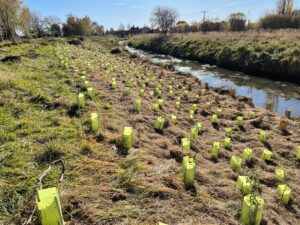
Seedlings planted by the students at the Tai Tapu site.
On a clear, blue-skied day in May, ākonga/students from Tai Tapu School marched down to the Huritini awa/Halswell river to get their hands dirty. For ten years the school has been using the river corridor as an outdoor classroom, fostering a deep connection to nature.
Armed with gloves and shovels, ākonga worked hard to plant and guard 600 tōtara, kāpuka, horoeka, koromiko, and mingimingi seedlings over the day. The Tai Tapu students didn’t shy away from this hands-on work – in fact, the school has been doing this for over a decade.
In 2012, ākonga and kaiako/teachers decided to start planting native trees along the river to restore the area and make it a thriving habitat for birdlife. A year later they paired up with Te Ara Kākāriki, a charitable trust based in Selwyn, who provided the plants and guidance that kickstarted, a so far, decade-long project of environmental stewardship.
Learning in nature’s classroom
For Enviroschools facilitator Matt Stanford, the Tai Tapu School planting was the first project he got involved with, all the way back in 2013. He now regularly visits the site to assist with planting and teaching ākonga about native wildlife conservation.
“We match schools with sites that are as close to the school as possible so they can use them independently as outdoor classrooms, and this increases their sense of connection to that place,” Matt explained, talking about the wider reach of the restoration.
Blossoming beyond trees

Facilitator, Matt, shows students how to identify kānuka and talks about the properties before they harvest a small amount for brewing tea.
Over the years, the Huritini awa site has blossomed into much more than just tree planting. Tai Tapu ākonga have used the area for the annual Garden Bird Survey, harvested harakeke (that previous students had planted) for weaving, and even created a QR trail as part of their ICT learning curriculum.
Excitingly, the project has seen a ripple effect within the community. During the most recent planting, Matt noted how well used by walkers the pathway along the river was. He felt this was significant because in 2012, he recalls, locals didn’t even realise there was river access. Recent developments have also seen adjacent landowners contribute to the restoration efforts.
Legacy of growth
The native trees planted at the project’s beginning are now well established, and it amazes ākonga to walk through the site and realise that the students before them created this ngahere/forest.
“Taking a hīkoi/walk along the Huritini awa is like walking a timeline of growth over the last 11 years,” said Matt, “but there is plenty left to do!”
Acknowledgement: Thank you Enviroschools Facilitator Matt Stanford, Breeana Thomson Environment Canterbury and the team at Te Ara Kākāriki for giving us permission to use the material from the original article here.
School celebrates a decade of planting along the Halswell awa | Environment Canterbury